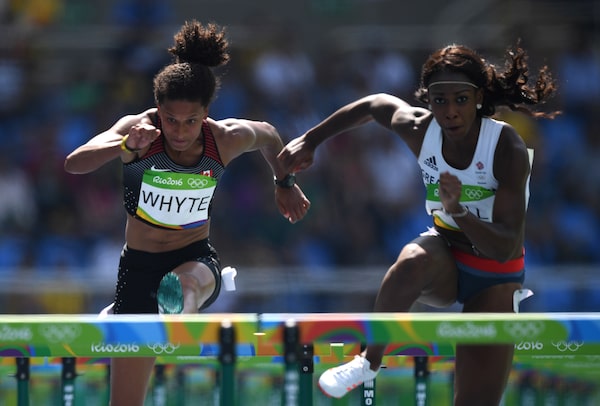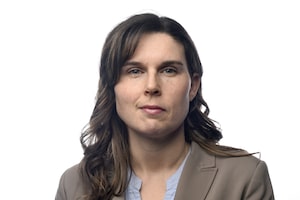
Canada's Angela Whyte, left, and Britain's Cindy Ofili compete in the Women's 100m Hurdles Round 1 during the athletics event at the Rio 2016 Olympic Games at the Olympic Stadium in Rio de Janeiro on Aug. 16, 2016.OLIVIER MORIN/Getty Images
As the Summer Olympics draw closer, it’s worth recalling a poignant story about an inspiring Canadian who competed in Tokyo the previous time the Games were held there.
It was 1964 when Vancouver sprinter Harry Jerome ran to a bronze medal in the 100 metres, one of the most remarkable comebacks track and field had seen and solidifying hero status for a Black athlete who had faced racism and criticism.
It had been an up-and-down few years for Jerome. The media had trumpeted him as Canada’s great hope for gold at the 1960 Rome Olympics, because he had already equalled the world record for the 100 metres and also eclipsed the Canadian record in the 220-yard sprint set by 1928 Olympic double-gold medalist Percy Williams. But an injured hamstring spoiled Jerome’s dreams in Rome. Then a gruesome quadriceps tear foiled him at the 1962 Commonwealth Games in Perth. The media portrayed Jerome as a quitter. Meanwhile, he was so severely injured it was thought he would never walk the same again.
However, Jerome overcame a complicated surgery to repair the leg muscle and a lengthy rehabilitation to make it to the Olympic track in Tokyo, where he finished third in the 100 metres and fourth in the 200 metres. Making that podium confirmed his place among the fastest men of his era and finally earned Jerome the respect of his critics.
So it’s fitting, perhaps, that the popular annual track and field meet named after the late indomitable sprinter will provide one of the few opportunities for Canadians trying to qualify for this summer’s Tokyo Games. But the big caveat is that the event is only for those who can travel to B.C., as the country grapples with the pandemic.
The Harry Jerome International Track Classic is Canada’s longest-running track and field event; the 38th edition is scheduled for June 12. It’s part of the Tokyo qualifier series recently created by Athletics Canada – nine meets across four provinces in May and June intended to give Olympic and Paralympic contenders the opportunity to qualify for Tokyo without having to leave the country. Athletics Canada says only one third of its estimated Olympic team of 60 has qualified. But now tightening restrictions across the country are complicating travel among the provinces.
Hurdler Angela Whyte of Edmonton faces an uphill battle to qualify for her fourth Olympics, but the co-captain of Canada’s athletics team at the 2016 Rio Games is not giving up. The campus of Toronto’s York University is mostly quiet these days, but as an elite athlete Whyte can work out at the athletics complex there.
Some Canadians have chosen to train or compete in the United States or in countries with looser restrictions around COVID-19 and more meets. Yet if they return to Canada, they face a quarantine period and lost training days.
Whyte has been in Toronto, rehabbing an injured foot, and has fallen too far behind in World Athletics world ranking points to qualify for Tokyo. So she will try the other way: to achieve the Olympic qualifying time of 12.84 seconds in the 100-metre hurdles at one of those Canadian meets.
Whyte hasn’t competed since before the pandemic began, save for a small meet in Niagara, which had a women’s 80-metre hurdles race – but she was the only athlete who ran it. She has missed being in the blocks with race-day jitters and having competitors in lanes beside her.
It’s an uncomfortable waiting game at this point, so she just focuses on preparing herself. She might compete in Ontario, or maybe in her home province of Alberta. Whyte hopes the restrictions at the Harry Jerome may ease so she might race there. It’s an event dear to her heart.
Whyte gets animated when talking about her victory in the 100-metre hurdles at the 2013 Harry Jerome. She had hardly slept the night before after a late drive in from Seattle and felt totally lifeless in warmups. Yet as soon as the start gun sounded, she breathed in the beautiful Burnaby, B.C., air and the beloved buzz of that meet, sprang to life, and won in 12.78.
“I love the Harry Jerome; it’s a special meet and he’s such a rich part of the history of our sport,” Whyte said. “I take it very seriously that this meet is named after one of our greatest athletes and I try to absorb that spirit. Even though I feel like my back is up against the wall right now, I still have to leave the opportunity for something special to happen.”
Nigel Hole, meet director of this year’s Harry Jerome Classic, said he was sorry he had to advise out-of-province athletes to refrain from booking travel for the meet. In accordance with B.C.’s provincial health order, however, only athletes returning home to B.C. can compete after producing a negative COVID-19 test and self-isolating – five to seven days if coming from another province, or 14 days if travelling from outside Canada.
This year’s meet is being spread out over three venues to ensure physical distancing: in Burnaby, Kamloops and Vancouver, with a likely maximum of 50 people for each event, including athletes and officials. Hole has no idea if he’ll have 20 athletes competing or 200. The event won’t have crowds of autograph-seeking fans, as it did in 2016, when Andre DeGrasse ran there before embarking for the Rio Olympics.
It will require meticulous planning to take what is usually a bustling, popular athletics meet and make it safe for pandemic times: only essential people, staggered event times and distance between competitors.
“There won’t be a stadium of cheering fans and it may not be a spectacle of an event this year,” Hole said. “But I still think that it could still be pretty special and heartwarming for these athletes, just knowing what they’ve all been through this past year and a half.”
Jerome competed at the first iteration of that meet in B.C., then billed as the International Olympic preview, just before he left for 1964 Games. Founded by the Achilles International Track and Field Society (which still runs it) it was a star-studded event at Vancouver’s Empire Stadium, including athletes from Canada, Jamaica, the United States and Trinidad and Tobago.
Jerome won the 100-metre race in that 1964 sendoff event. The rain at the inaugural meet, and the local fascination for track and field, isn’t forgotten by the founders.
“He was the most real example of ‘never give up,’” said Doug Clement, 1952 Canadian Olympic sprinter and the chair of the Achilles Society. “When you consider his impossible circumstances – a torn quadriceps and then being told by all the medical authorities here that that was it, that he was finished.”
In 1984 the Achilles meet was named after Jerome, who died two years earlier at 42 following a brain aneurysm.
With less than 100 days until Tokyo again holds a Summer Olympics, many of Canada’s track and field athletes will get their final chances to qualify in events in Ontario, B.C., Calgary or Montreal. Travel restrictions might hinder the number of athletes and level of competition at those events, or prevent some athletes from getting there at all.
“We’re still very keen to see this through,” said Chris Winter, Athletics Canada’s director of domestic programs. “We need to do everything we can to support our athletes and give them a chance to make those qualifying marks.”
 Rachel Brady
Rachel Brady